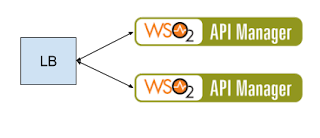Iterative approach is the choice for most IT related projects today.
In the same wary API management at your enterprise can follow an iterative approach that
will eventually lead to digital transformation.
If you have no problem using Cloud services just get a demo account and you are on your journey.
API
management can be achieved within a few hours using WSO2 APIM. You can
download the latest pack from http://wso2.com/api-management/, deploy
and configure it to be production ready instance within a few hours. The
deployment is as follows.
Pros
1 - The cost is for single instance and you will get 24*7 WSO2 production support
2 - Deployment is up and running within hours
3 - Minimum hardware/cloud infrastructure requirement (only one node)
4 - Suitable for starters
Cons
1 - No HA
2 - Not network friendly. Where are you going to run this instance? Not in DMZ as this need a database connectivity.
3 - The supported load really depends on your use-case
What
if you want HA? This is the next level. You need high availability.
The system should be up and running 99.99%. Then you will need another
node.
Pros
1 - The system is highly available
2 - The cost is for single instance and you will get 24*7 WSO2 production support
3 - Deployment is up and running within hours
Cons
1 - Not network friendly. Where are you going to run this instance? Not in DMZ as this need a database connectivity.
2 - The supported load really depends on your use-case
What
if your load goes high? You can make the passive node as a traffic
serving node. This means production subscription changes from 1 instance
to 2 instances.
Pros
1 - The system is highly available
2 - The cost is for two instance sand you will get 24*7 WSO2 production support
3 - Deployment is up and running within hours
Cons
1 - Not network friendly. Where are you going to run this instance? Not in DMZ as this need a database connectivity.
2 - The supported load really depends on your use-case
What
if you want to support more TPS OR complex throttling OR adhere to
standard network patterns, where the un-trusted connections are
throttled out at the gateway itself. Then you need a distributed
deployment where the deployment looks like below. This deployment allows
different functional component of API management to scale differently -
and these components scale at different proportions.
For
this type of deployments you can get solution architecture help from
the WSO2 team. This is an API empire that needs to be planned
precisely.









